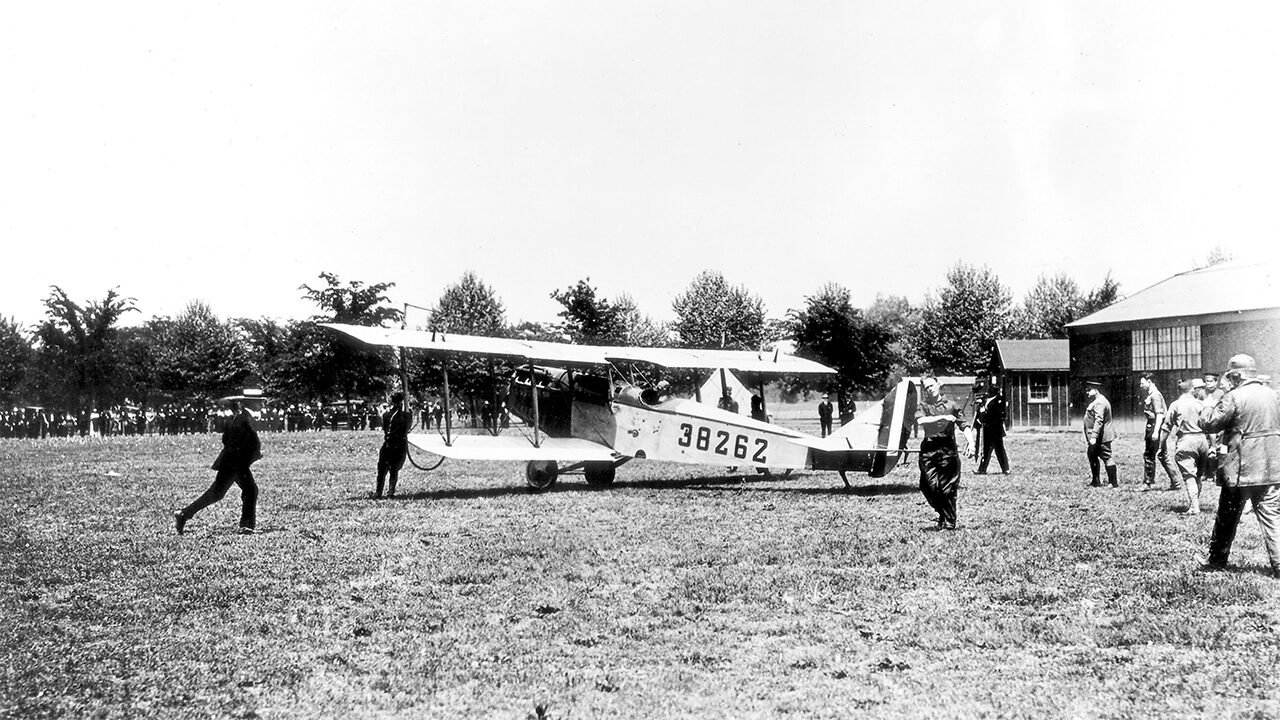
Dorian Walker, the pilot with “the most flight time on earth” in the Curtiss JN-4, a biplane called the Jenny, invited me to Louisville, Kentucky, at the end of September 2022 to ride in one. For no reason I could explain I had wanted to ride in a Jenny for decades but did not think it likely due to the scarcity of the planes and insurance regulations. He would fly his plane up from Bowling Green, where his educational non-profit, Friends of Jenny, is based, for the airshow marking the centenary of historic Bowman Field. I drove down the night before so I could watch the plane fly in the next morning.
A PBY flying boat and a long-legged Russian prop trainer already sat on the concrete apron at Bowman, and other historic planes would arrive every hour, but seeing the large-winged Jenny appear in the air over the terminal was like spotting a movie star on the street. JN-series biplanes have been used in many films, including The Great Waldo Pepper, the 1975 drama with Robert Redford about barnstormers in the 1920s and death. As the first mass-produced American airplane, and the first aircraft ever seen in the skies over thousands of American towns, the Jenny is also a national memory.
Dorian was flying her from the rear cockpit—Jennys were built originally as trainers for WWI and have controls in the front seat too, where another man was sitting—and he side-slipped hard in the wind to lose altitude and line up the landing. After he taxied off the runway to the terminal, he killed the engine, climbed out of the plane in his jodhpurs, boots, leather jacket, leather helmet, and goggles, got on his hands and knees, and unselfconsciously kissed the Bowman Field logo on the tarmac.
… seeing the large-winged Jenny appear in the air over the terminal was like spotting a movie star on the street.
He swapped his helmet for a red Friends of Jenny hat and came over to talk. He and his mechanic had left Bowling Green at 6:15 am and refueled at Elizabethtown, Kentucky—not their planned stop. The Jenny can do 65 miles per hour relative to the ground, but that day they had done 40, due to a bad headwind. The departure from E’town, he said, was the quickest takeoff he had ever had, and he zoomed his hand up at about a 50-degree angle to demonstrate. He said he could not tell if he was shaking from cold or the Jenny’s vibrations.
He has more than 430 hours in the Jenny alone, but I could see it had been a hard day. He was in a terrific mood, for all that, but my ride had to be postponed, because the wind, only 15 mph then, was already at the limits of safe flight and would strengthen as the morning progressed.
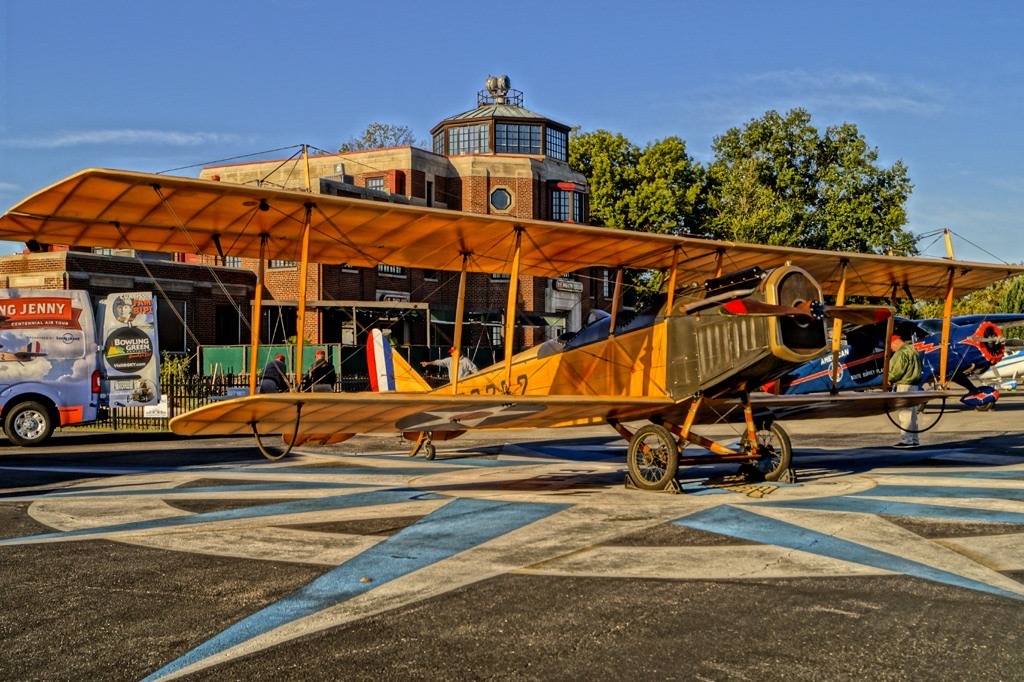
The FOJ Jenny at historic Bowman Field, Louisville, Kentucky, 2019. (Courtesy Friends of Jenny)
After coffee and lunch, Dorian, who thinks of himself as an ambassador and educator, stood on the tarmac for hours, discussing his Jenny and his life with visitors. With his wife, Elaine, he makes his living as a filmmaker (PBS documentaries, Unsolved Mysteries, Teen Witch), so he appreciates the power of storytelling and communication. He clearly loves the beauty of the Jenny, its history, and the connections it makes with others, especially young people. He has had offers from museums to buy the plane, and he knows one day he will need to do something else with her, but it is very important to him that she “not be hanging from the ceiling” somewhere but purring overhead in the sky.
Other historic planes, including a shining DC-3, landed and rolled past. He said none of those other planes would be there if it had not been for the Jenny, with its innovations in control surfaces and other flight technology.
“The Jenny…is what put aviation on the map in America,” he said.
• • •
Before WWI, the US Army experimented with ineffectual pusher-style planes (think Wright Flyer) with their propellers, engines, and gas tanks behind the pilot. These killed “more than half” of those who crashed in them, Dorian said, “not because they hit the ground at 30 miles an hour—that could kill you but you could also walk away from it—it was that the engine…crushed them.”
American aviation pioneer Glenn Curtiss and English engineer Benjamin Douglas Thomas created the tractor-style Jenny series in 1915, with its engine out front. After several iterations, it was seen to be a huge success. As many as perhaps 10,000 JN biplanes were made for the war—so many that the work had to be done in six factories around the country, including at the St. Louis Bridge company, Dorian said, which knew how to string and tension the mile of cables that give each Jenny’s airframe rigidity. Jennys trained 95 percent of all aviators from North America during the war and was used by the army until 1927.
He has had offers from museums to buy the plane, and he knows one day he will need to do something else with her, but it is very important to him that she “not be hanging from the ceiling” somewhere but purring overhead in the sky.
Dorian said, “These young men… came from all walks of life. They were teachers, pharmacists, doctors, farmers—and [t]hey got bitten by the bug. They said, This aviation thing is amazing!”
Dorian invited me to imagine America then, with few roads, telephone poles, lines, billboards, or even towns. “We had no landing fields, no notion of aviation other than birds flying above us,” he said. “All we had were trains, wagons, and now this new automobile thing. So you’re at the infancy,” Dorian said.
In 1918 Jennys were used to establish the first US Air Mail route, but there were few other jobs for pilots. (The Friends of Jenny plane is mostly a reconstruction from original plans but is numbered and painted in homage to the first of those mail planes, which made the run from Washington, DC, to New York City.)
The U.S. government had paid about $6,700 per plane in 1917, Dorian said. “A year after the war you could buy a Jenny complete, unassembled, in its box, with two spare engines, for as little as $350.” The planes had big wheels and tail skids, and “All they needed was a big farmer’s field” to operate. Amelia Earhart learned to fly in a Jenny, and the first aircraft Charles Lindbergh owned was one.
“Pilots said, ‘I don’t want to be a teacher anymore, I want to be an aviator.’” They had been trained to do maintenance and repair themselves, there were no regulations to speak of, and the country was wide open. It seemed a dream of freedom. To support themselves, some began “the process of early barnstorming: taking the story of aviation to America—first with a ride over your hometown”— drumming up business by flying low and slow over downtowns. The Jenny’s “got huge wings, even for today’s aircraft,” Dorian said—43 feet, seven inches—”so you could see it, like, ‘Wow, look at this giant bird!’”
Amelia Earhart learned to fly in a Jenny, and the first aircraft Charles Lindbergh owned was one.
Pilots “went to every podunk town they could find, starting with the big cities and working down,” Dorian said. But now there was competition for audiences; “now we gotta do aerobatics.” There developed, Dorian said, “an element of risk and a little bit of what I call the Roman gladiator spirit, where they came out to watch the gladiators fight not just because they were skilled, but because someone was gonna die. So there was that dark side of the spirit.”
• • •
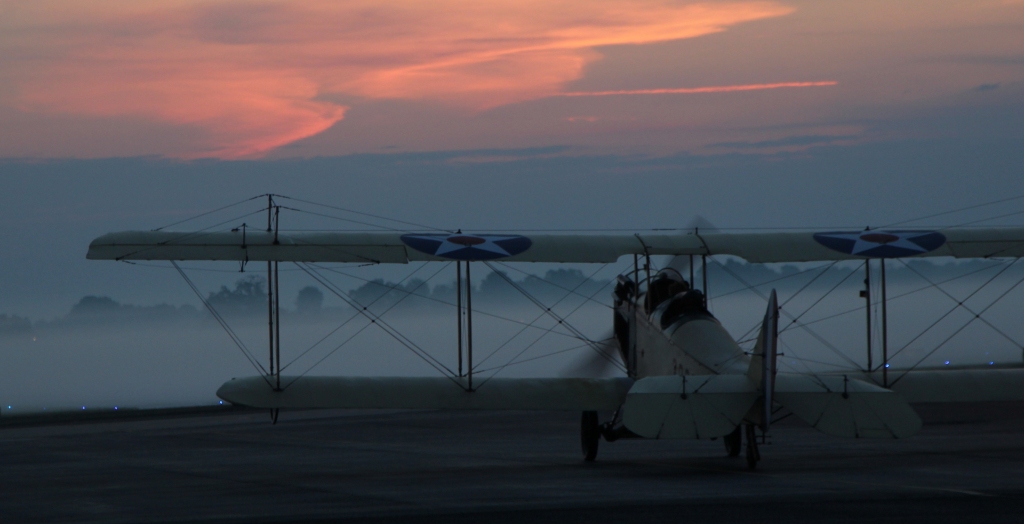
Takeoff into the sunrise. (Courtesy Friends of Jenny, Kelley Coppinger, photographer)
The idea of freedom is odd. The technologies we invent to free us (up) do so only within specific contexts and impose their own restrictions. Flying free as a bird is a tradeoff with the demands of weather, terrain, mechanical systems, others’ concern, and (sometimes) controlled fear.
“This is the only Jenny in the world that flies regularly cross-country,” Dorian told me. His team has been to eighteen states. The original seats are wooden, the vibration awful, the engine loud, and the slipstream blasts around the open cockpits. The flight to Detroit took eleven and a-half hours and six fuel stops.
“The view from the cockpit was that of a timeless America, rural landscapes and two-lane blacktop,” Dorian said. “[S]itting in the 26½-inch cockpit that Charles Lindbergh and Amelia Earhart sat in, as well as those valiant Air Mail pilots who would be looking at what we [saw], my thoughts drift[ed] quickly to, How lucky are we, two American Aviators crossing this great country as those before us did over one hundred years ago!”
There developed, Dorian said, “an element of risk and a little bit of what I call the Roman gladiator spirit, where they came out to watch the gladiators fight not just because they were skilled, but because someone was gonna die. So there was that dark side of the spirit.”
Like any pilot, he is always looking where to land if something goes wrong, so that “there’s a field, there’s a field…here’s an area where we’re not going to have a field, how am I going to nurse it over here?” He called this “the balancing act of risk” and “the constant…antithesis of…the freedom of flight.”
He said he can fly his other plane, a 1941, high-wing monoplane called the Porterfield, “with my eyes closed.” With the Jenny, “you’re working all the time.” He said the Jenny “keeps me legal,” because if everything was as easy to fly as the Porterfield, “everybody would be doing it.”
“The Jenny airframe doesn’t have what we now call ‘dynamic stability,’” Dorian said. More modern planes let you get to cruising altitude and take hands off wheel or stick. “This airplane…has all this drag, [this] mile of cables, and struts, all fighting the flow, the lift of the wings…. You’ve got wonderful lift, and tremendous drag. So now that’s how you’re only flying 60 miles an hour in an airplane that’s this large. And what you’ve got to gauge, as with any airplane, is, What’s the speed at which it stops flying?”
“When I stop being scared then I’ll stop flying. Because every time I fly this it’s like the first time. Honest to goodness, it’s like the first time, because there’s just so many things you’re coordinating to make it seem like it’s easy.” These many things, of course, are done in the open air, with almost no instruments, in a plane made of wood, fabric, and wires.
“Does the thrill go away?” I asked.
“It eases,” Dorian said. “It never goes away. It eases.”
Experience and skill play their parts, and Dorian said he is an expert at taking only calculated risks. “But I’d be crazy to say that fear doesn’t motivate you. Because I don’t think anybody ever climbs in an airplane and says, Yeah, I’d like to die today.”
• • •
Dorian asked me to wait to take photos until he had reached into the Jenny’s cockpit and “put her skirt down”—lowered the plane’s elevators, the flight control surfaces on the tail.
“The Jenny is a mythical, spiritual, wonderful, perplexing lady,” he said. “Out of respect for her being a bewitching lady, we like to keep the elevators down just to give her the dignity of the full presentation of her beauty and serenity of an age by-gone.”
I was reminded of how we name things that transport us with female names, to bring comfort and the romantic fantasy of protection to the cold sky and sea. Maybe men have done it too to pretend loved ones buy into their flights from them.
The Friends of Jenny (FOJ) have made some updates to the original plans. In 1917, Jenny #38262 would have been covered in Irish linen. Now FOJ work with a lab in California that specializes in aircraft paint and fabric to get translucent varnish.
“One of the most beautiful things about this airplane is the wings,” Dorian said. “With the translucency, you can see the actual structure of every wing rib and spar. It’s truly a work of art, this phenomenal engineering that makes the wing work.”
The radio is “marginal at best—the old girl still fights modern technology, and she’s fought that since we put her first in the air, in various stages”—so Dorian often has to call field towers or members of his ground crew from his cell before leaving.

Pilots Dorian Walker and Steve Guenard maneuver the Jenny through a muddy field into position. (Courtesy Friends of Jenny, Mike Lent, photographer)
Most of the rudimentary instruments are original, and one wooden interior fuselage brace is from an original Jenny, but most of the plane is new materials. FOJ added a detachable wheel to the tail skid, for concrete runways, and brakes were installed, since the original brake, the tail skid, was no longer effective. The original Curtiss OX-5 engine, a 90-horsepower V-8, has been updated to a newly-manufactured Chevrolet Brothers V-8, which “portrays” a 150-horsepower Hispano-Suiza engine that came after the OX-5. There is an electric starter now, which eliminates the need for hand-turning the prop.
Still, the plane has most of the benefits and deficits of the original, which is to say the consequences of a kind of freedom. Every normal modern airplane must have a transponder so it shows on radar. Because the Jenny does not, she is a ghost and cannot fly into many airfields.
“The Jenny is a mythical, spiritual, wonderful, perplexing lady,” Dorian said. “Out of respect for her being a bewitching lady, we like to keep the elevators down just to give her the dignity of the full presentation of her beauty and serenity of an age by-gone.”
“Because we’re wood, we’re impossible to see,” Dorian said.
“Once this thing is in the air, she’s kind of on her own,” Dorian said, “and she allows you to hold on, you know? [S]he likes to shake her tail, and so she’ll go this way, gotta bring her back this way.” Steady headwinds are manageable if not too strong, but with gusting “you get into trouble.”
“If there’s a headwind, she’ll find it,” he said.
• • •
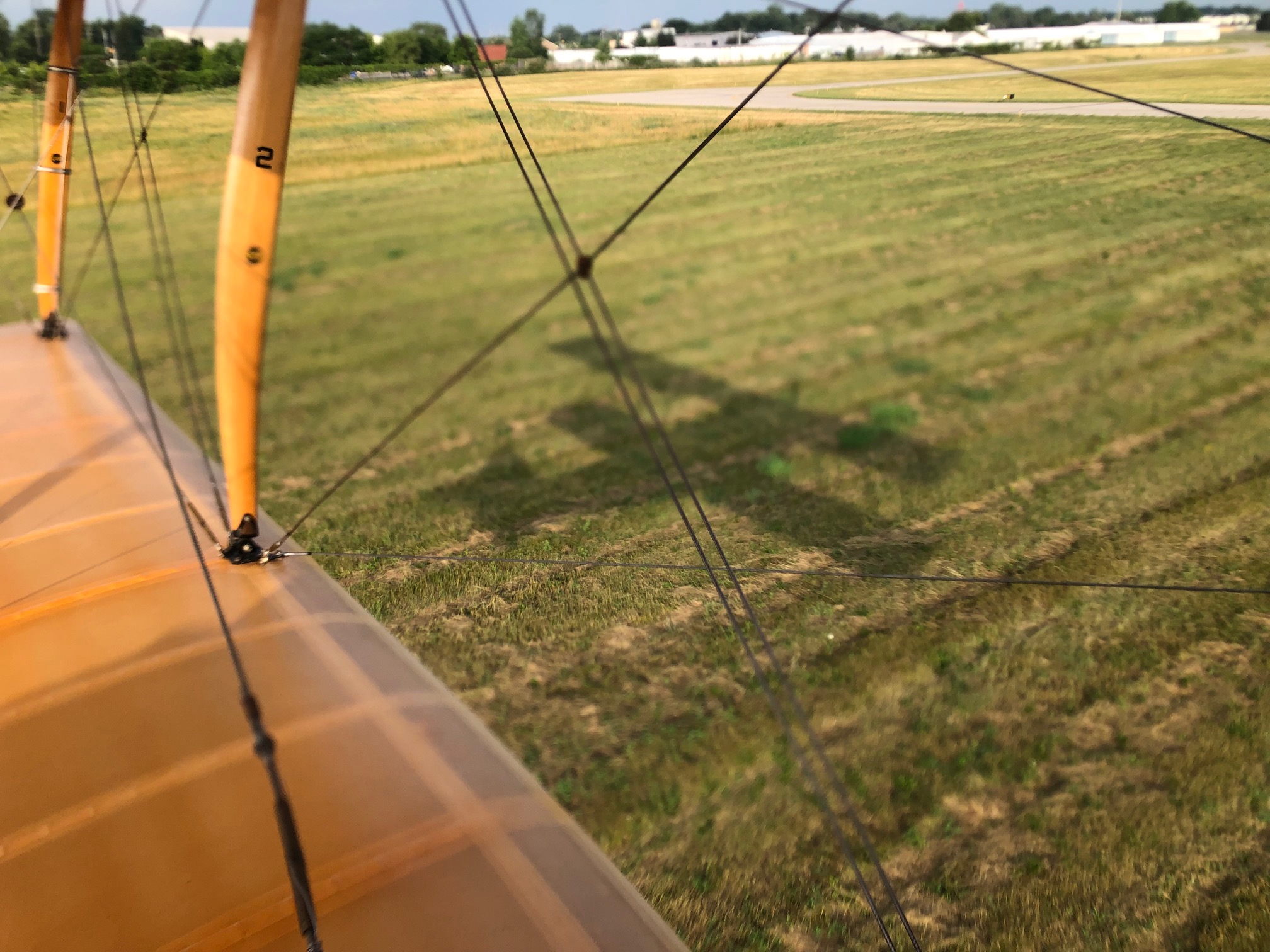
An old-school grass takeoff, with the plane’s shadow seen through the lens of exhaust heat. (Courtesy Friends of Jenny)
“In this airplane, often the engine would quit,” Dorian said cheerily, “and they’d have to put in to a very small field. They didn’t have brakes, so what they would do is put it down and ground-loop it, and the worst that would happen is that the wing skid would break, if it was bamboo or metal.
“I’ve been able to experience that myself, on departure out of Paducah on the way to Cape Girardeau. The engine failed on departure. It was about a hundred feet in the air, and just beyond the runway, so there was no place to land; it was all trees, and there was a little field, it was about 400 feet [long], a new cornfield. Put in the cornfield, and of course it was going right for the trees. Ground loop[ed] it to the right, [spun] around, and even though the engine quit, I had enough oomph to turn it towards the road and stop there. I could have hung a sign up, Rides five dollars, and I would have had people there—if I could have gotten the engine started.”
“And I’ve landed in a bean field—that was up in Illinois…fully mature beans, but they’re great braking, because you land and it just stops you. You want to land tail-down, known as a three-point landing. You always land in a Jenny tail-down anyway, because if you land wheels-up, you can go over.”
“But the off-field landing of all time for me was: I was taking it cross-country, I was by myself…. I had just flown over miles of farmers’ fields. I [got] to the outskirts of Nashville, power lines coming up, neighborhoods starting to form, a river there. And the engine just stopped. Dead. And I’m going, Hmm, that sounds interesting.
“I thought I’d better take care of my next business while I’m trying to get it to start: find some place to put it down where I’m not going to kill anybody, land on anybody, destroy any property, and—oh yes—save the airplane and myself, all kind of concurrently.”
He put the Jenny down in a “really rough” “J”-shaped field, knocked over a couple of trees, and bent the tail wheel, but otherwise “everything was good.” He started walking in his leathers, past an abandoned house, down a long pathway to a country road, but there was nothing around and no traffic. He thought of The Twilight Zone episode about the last man on Earth.
It took a while, but he found a house with someone in it, who called for help. His crew drove from Bowling Green and Nashville and saw the plane would have to stay overnight. The bigger concern was that the field was not long enough for a normal takeoff, so Dorian would have to get off the ground, bank, and finish his departure on the leg of the J.
The next morning, “crowds are starting to come,” he said. The people, dressed in their everyday clothes that looked like they were from the 1920s, wanted to help. A man with a tractor cut a path on the J.
“… I had just flown over miles of farmers’ fields. I [got] to the outskirts of Nashville, power lines coming up, neighborhoods starting to form, a river there. And the engine just stopped. Dead. And I’m going, Hmm, that sounds interesting.”
“We prepare the airplane, and now we’ve got about, I don’t know, 35 people. Which is a lot, given that there’s nothing…around,” Dorian said. “It’s just trees, and the field, and an abandoned farmhouse. And all these people in coveralls, and girls in, like, gingham dresses. You know? And bringing picnics! They’re bringing picnics too, it’s like….” He laughed.
“So now it’s the classic: We have to wait for the wind, cause the Jenny doesn’t like crosswinds. That’s…the one kind of serious thing, when winds come up, with this airplane, because…you can get hurt.” He walked the field, calculated, noted the 60-foot trees all around. The locals helped him to the other end of the field by holding or “walking” the wings, and two stout men held the plane back until he built full power. He nodded, they let go, and he made it into the air.
The funny thing, he said, was that despite the feeling of having gone back in time, the locals all had iPhones and shot videos of him departing and sent them to him later. In one of them a man shouted “in a good ol’ Tennessee drawl, There he goes! There he goes! O my gosh, I thought he’s gonna hit that bush!”
Dorian flew the plane back over in gratitude, like a rehabilitated bird released back into the wild. A “sweet Tennessee lady was at the other end [shooting video with her phone] and so you see me banking, coming back over ‘round this way, overhead. She says, Oh my God! He made it!”
“It was reminding me of all those photographs I’ve seen of all those guys that went out and either got off their field or didn’t get off their field, and those people that were surrounding them as they did.”
• • •
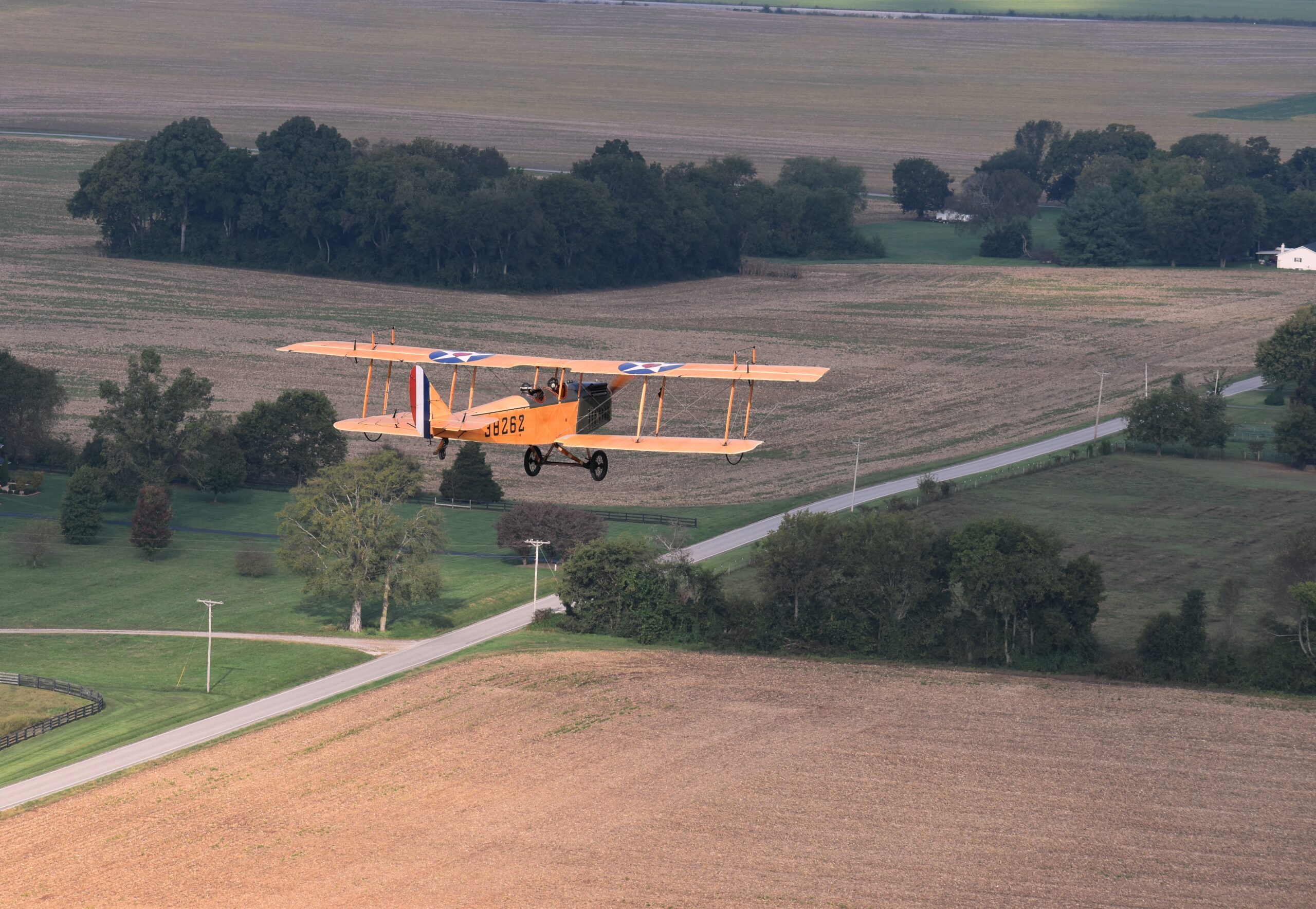
Very little difference in this photo from a Jenny in the 1920s, following the road home. (Courtesy Friends of Jenny, Maggie Shelton, photographer)
Dorian said that “as I start looking back towards things I’ve done in my life, I guess others could look at them as pushing envelopes, maybe. But I’ve never looked at it as pushing. I’ve just done it because, ‘Oh, this is something I need to do.’”
He got to his Jenny, in fact, while making a documentary called Legends of the Sky!: The Jenny. He had heard two stories about existing Jennys and thought one of them might serve as an ending to his film. “[O]ne was being built, ironically, by a guy who became a great friend, Brian Karli, whose Jenny went down, and Ron, his partner, was killed in it,” Dorian said.
Dorian flew the plane back over in gratitude, like a rehabilitated bird released back into the wild.
“The other one, the guy was just a real character, from upstate Ohio, [who] had for 30 years been working on this project, and he wasn’t even a pilot, he was a dreamer…but when I went up to shoot the part, where the FAA came out and inspected it, they failed it. […] It looked beautiful…hanging from a ceiling, but it wasn’t flight-worthy, and he didn’t understand why it wasn’t, because he was an engineer, and he had done all the testing to make sure it was every bit as strong as if he’d done it the way the FAA said you should do it and the way the plans had it.”
(“The only original Jenny you’ll ever find, original-original, is hanging in the ceiling or sitting on the floor at…the Smithsonian,” he said.)
Dorian bought the man’s plane, and while “there’s a few pieces left from that build,” he and his team applied original 1917 plans and rebuilt the Jenny with help from volunteers, which “built into this amazing network of people that…was the genesis for the nonprofit Friends of Jenny.”
“This airplane has got an amazing place in American history, and we’re just proud, this whole team of us…four team leaders, each with a specialty, and about 15 really dedicated volunteers that rebuilt it.
“It went in the air the first time in 2013. Then I let a naval aviator fly it, who crashed it in 2017, so we totally rebuilt it [again], which allowed us the technology of change to get what you’re seeing now,” he said, such as the new varnish, which made her translucent, like a spirit.
• • •
A week later I drove to Bowling Green for my long-anticipated flight. Dorian sat at a table in the terminal with his mechanic, Mark, and gave me a preflight briefing. He told me how to sit: feet back, so as not to block the rudder control on the floor, and legs open because the trainee stick would be pulled back hard when Dorian flew, as indicated by a U-shaped divot in the leather seat at my groin.
Cables ran down both sides of the interior of the fuselage, through my compartment, since at the time the aircraft was engineered, they had not figured a way to cover them or their pulleys for safety.
He also asked me to sign a waiver I had anticipated. I laughed at the place in the contract that went hard on crashes and fire.
“Aviation was brand new, and they were concentrating on performance first, safety last,” Dorian said.
On my right were trim cables, as well as the comms cable. On my left was the throttle cable. Rudder cables ran down both sides, as did aileron cables that passed through a pulley. Obviously, I was not allowed to touch or impede any of them, and I needed to keep my coat, phone, gloves, and hat under control.
“You don’t want [them] to fall down into the cable or controls,” Dorian said, “because it could make them freeze or stick in the position they’re in, and then we would have a real problem.”
He also asked me to sign a waiver I had anticipated. I laughed at the place in the contract that went hard on crashes and fire. Dorian laughed when I asked if he would give me the Waldo Pepper treatment (a whack to the head with a piece of lumber to prevent further suffering) if we crashed. (He loves the film for its aviation authenticity.) Mark laughed really hard when I asked if there was a fire extinguisher onboard I should know about. He said we would be lucky to get as much weight in the air as we already had.
Mark said the engine would be loud, but the wind would not be so bad, as it would slip over the wing and small windscreen at my face. If I wanted to feel it I could stick my hand out, and if I wanted to hear Dorian better in my headset I could duck down more behind the windscreen. Mark told me to listen for the hum of the airplane, which came from the wings, control surfaces, and cables vibrating in unison. (Dorian pulled a face and said he had never heard that, as if it did not exist.)

Dorian in his Jenny, flying home. (Courtesy Friends of Jenny)
Dorian said if fire broke out in mid-air he would slip the plane sideways to try to keep flames out of the cockpit. He told the story of a “friend of mine [who] went down in [his] Jenny, in flames” with a passenger. He was “one of the finest pilots in the world,” former Air Force, “a Delta check pilot, Delta captain, had been in vintage aviation all his life. I mean, you couldn’t find a better pilot.” The propeller started delaminating as they took off, only 200 feet from the ground, rocking the entire engine frame and rupturing the fuel line, which sprayed on the hot engine and ignited with a flash-bang. “T]he fire…engulfed them, they were burned in the 200 feet it took to fall,” Dorian said. “Whether he side-slipped or anything, he was gone.”
“Where’s the gas tank? I asked.
“Right in front of you,” he said, and we all laughed.
• • •

The view from the pilot’s cockpit. (Courtesy Friends of Jenny)
“How much reality do you want?” Dorian asked at the last minute.
I laughed yet again without knowing why. “All of it,” I said.
He was asking if I wanted to take off and land from the concrete runway or a grass strip. People told him the grass strip made them feel more connected to the past. I said grass strip.
Mark laughed really hard when I asked if there was a fire extinguisher onboard I should know about. He said we would be lucky to get as much weight in the air as we already had.
We walked out through the hanger, where the Jenny sat with three high-wing Cessnas and a little fiberglass experimental plane. Corporate jets taxied past, and Dorian said two of those pilots were also pilots for the Jenny. He said most of the people who fly the plane are 30,000-hour guys, retired airline pilots. They live all over the country, fly Stearmans, T-6s, “have a lot of experience and have always wanted to fly a Jenny, so it’s like a big, big, big deal to them.”
Mark showed me how to climb in the front cockpit. I had gotten in the rear cockpit in Louisville, which Dorian compared to mounting a horse, but the front seat was much tighter and under the top wing. There would be no quick exit.
“What’s he done with this?” Mark said, fiddling with my five-point harness. He got me strapped in tight and buckled a leather helmet, goggles, headset and microphone on me. I sat there as Dorian got things right. He was unhappy with the radio, which was cutting out, his voice rising a bit when Mark said he did not know what that problem was, as if it did not exist. In the end they decided good enough.
The electric starter fired up the engine. The straight pipes off the V-8 were loud even with my earphones. We taxied around the hanger and down a runway, Dorian talking periodically to the FBO (fix based operator), who has a courtesy radio, in lieu of a field tower, weaving the Jenny like a snake to see around the nose. Some distance from the hanger we turned and pulled into the grass, and the plane immediately stopped rolling. It took a hard, loud burst of power to make her move again, and Dorian turned her 90 degrees, pointed south for takeoff into the wind. He told me on the intercom, “Hang on, I’m going to power it up one time,” and held the brakes as he rolled on the RPMs. He throttled back and said it was all okay.
He got final clearance then started rolling forward. It was still hard to see around the nose, but very quickly we were going fast on the grass, then the tail came up and I could see straight ahead past the engine manifold. Very soon after that we were airborne and flew along low for a few feet, but by the time we passed over the terminal at the small airport our friends waving on the runway were small. It took a couple of minutes to get to cruising altitude at a thousand feet, then Dorian throttled back. The buildings and fields below were sharp but distorted in the lens effect of the hot clear exhaust in the cold. The sky was utterly blue, and no wind was forecast past noon, perfect conditions for flight. I did not hear the hum.
We banked east, flew in low over the Aviation Heritage Park, and Dorian throttled back in honor of the military veterans recognized there. We drifted a bit; he likes the relative quiet. Then he powered up, and we turned north along the highway, flew west over the Corvette museum, then south again over beautiful fields, the nearby Barren River winding like a snake, the hills, trees, and buildings (all the things the Jenny does not like) of Bowling Green, which Dorian narrated proudly: there’s City Hall, that’s Western Kentucky University, that’s the historic rail depot. I had to bend forward, best I could, to duck out of the wind to hear him.
We returned to the airport from the southeast, passed over a large cemetery, and lined up on the grass again. It was all going quickly and somewhat violently, it seemed to me. Dorian may have slipped the plane sideways to lose altitude, and the engine was at varying speeds, the nose at varying angles. We seemed to hit the ground quite hard, though of course the seats were original wood without springs, and the video I shot shows there was nothing hard about it. There were two more jolts and we were rolling quickly and then slowly through the dry, shin-deep grass. Mark had gone to church.
It took a couple of minutes to get to cruising altitude at a thousand feet, then Dorian throttled back. The buildings and fields below were sharp but distorted in the lens effect of the hot clear exhaust in the cold. The sky was utterly blue, and no wind was forecast past noon, perfect conditions for flight. I did not hear the hum.
It was all safe as houses, and twice as fun—an opportunity of a lifetime, and powerful enough an experience that I still have a hard time overlaying it on my childhood dreams of flying in a Jenny. For now, let me say that on this day a complicated little freedom machine called the Jenny—built to aid warfare, at once fragile and powerful in its utility, and as beautiful as a moth in the daylight—transported me through time and space and let me return to people I love.
• • •
After the flight we went back to the terminal and sat and talked. I asked Dorian about balancing freedom and its antithesis.
“That would be a good debate,” he said. “How do you define risk takers over foolish people? Every time I get in that airplane—or anyone gets in an airplane, or you get in your car, you’re taking a risk, but it’s a risk that millions and millions of people take every minute of the day. You start narrowing down those risks as you start going up this ladder of things that could possibly go wrong.
“You know, we had this airplane,” he said, motioning to a DVD of his new film, Legends of the Sky: The Liberty Plane, “the only original flying DH-4 in the world, and it’s right here.” Lindbergh had used a DH-4 to fly the first air mail between St. Louis and Chicago. The DH-4 was called “the flaming coffin” then, and Lindbergh had to parachute twice from them on his route.
Four people owned this particular plane, but Dorian was its chief pilot. “And I got it into the air here,” he said. “I had about four hours of testing on it, but this was its first flight, and got it in the air, and got it up and turning, and the controls locked. So by the time I had nursed it back to the field, I was in a knife-edge.” He held his hand sideways to demonstrate. “So that was my landing configuration. And this thing, the gas tank’s behind you,” he said, pointing at his back. “Up front, a mere 18 inches in front of your rudder bar is the 894 pound, 12 cylinder, 400 horsepower engine.”
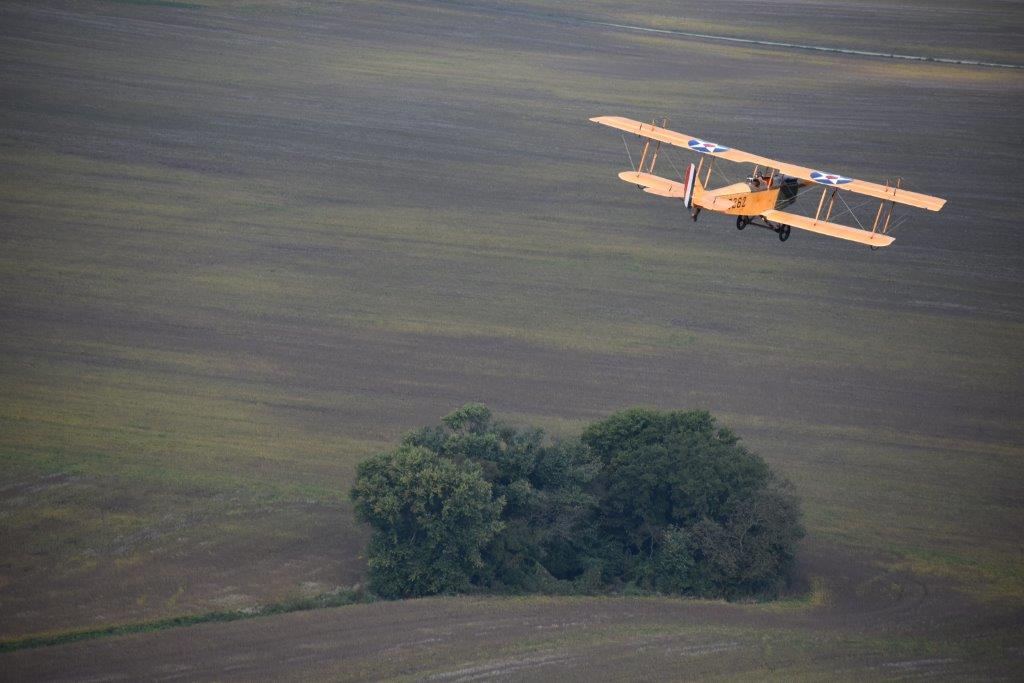
The greening fields of Kentucky are a safe refuge for the Jenny in case of emergency. (Courtesy Friends of Jenny, Maggie Shelton, photographer)
“So how many people would have climbed into it? I couldn’t wait. I was very cautious, I had read everything I could possibly read to properly fly this thing. Which also helped me in the recovery of bringing it back, so I didn’t land in the hotel or the neighborhood over here—to nurse it back even though I had no lateral control.
“I’m using rudder and elevator to try to get it back over here. Its cockpit was a little more complex than the Jenny, there were all kinds of valves and things that had to be shut off. I was able to get it back to where I could spot where I was going to hit, which was in the grass, away from [everything]—because you go through the process, keeping people safe, keeping buildings safe, keeping yourself safe, keeping the airplane safe—and immediately, even as I’m just above the ground, I said, There’s no possible way to recover.
“I just start clicking down all [the items on a mental checklist]—okay, shut the fuel off, shut the engine off, and keep the wing down, ‘cause I had 150 pounds [of weights] in the back, which is required to fly it…which would come straight through the fuel tank and my back if I hit it this way,” he said, using his hand to indicate nose-in to the ground.
“So when I hit this way”—his hand showed how he put the wingtip into the ground first—“it spun, and sure enough, those 150 pounds went right through the side of the fuselage, right behind me. And I shut everything down, no fire, came to a rest, walked away.
“In that day, which was a terrible day for me, because we’d worked on this for two years….” He paused. “But for my wife, she was out there, and she was actually filming it, it was devastating for her. Because I was just on the other side of a rise, she couldn’t see. And she was with the airport manager, she was recording this, and I just literally disappeared like this.” His hand went over an invisible rise and then down. “But there were no flames, no smoke or anything, so it was….” He stopped.
I asked how old a man he was when he crashed the plane.
“Oh, this was two years ago,” he said, and we all laughed.
• • •
Dorian’s father went in the Army Air Corps in 1939, and though his father “did a lot of amazing things” in his life, he was not allowed to fly because he did not have a high-school education. Still, many of Dorian’s earliest memories are from army air fields and aviation-themed hobbies, such as model building.
Dorian told me, “The only reason I went to college was to fly. […] I had no interest in any other career in my life when I went to college.” But he ended up an art major, and a back problem that had never caused him trouble made the army decide to keep him from “the one thing I wanted in my life, which was flight.” He too has done many things: served as a Ranger instructor stateside, as an infantry officer in Vietnam, where he also worked with Special Forces, Air America, and Saigon Support Command.
“Any time something went wrong, they sent us in to find out what went wrong and ensure it wouldn’t go wrong again,” he said. These recons were sometimes on the ground but more often in the air, occasionally purposely drawing fire “when it seemed the only way to find out where [the enemy was] and why we were losing convoys in certain sectors.”
“So when I hit this way”—his hand showed how he put the wingtip into the ground first—“it spun, and sure enough, those 150 pounds went right through the side of the fuselage, right behind me. And I shut everything down, no fire, came to a rest, walked away.”
He compared the Huey pilots of that time to the “peach-faced” aviators of WWI he admired.
“[They’re] flying in a way that no one’s flown before…. [T]hey’re given these [aircraft], are paid, get free gas, to do anything they want to. They’re like hot rods, you know? And they treat [them] like hot rods. I’d go on a visual recon down through a jungle, where there was a swath cut in the jungle where the road went through, and [the 19- and 20-year old Huey pilots] would go in this way, you know?” he said, knife-edging his hand sideways. “It was like, You guys, you guys, you guys, I love you guys. You are amazing.”
• • •
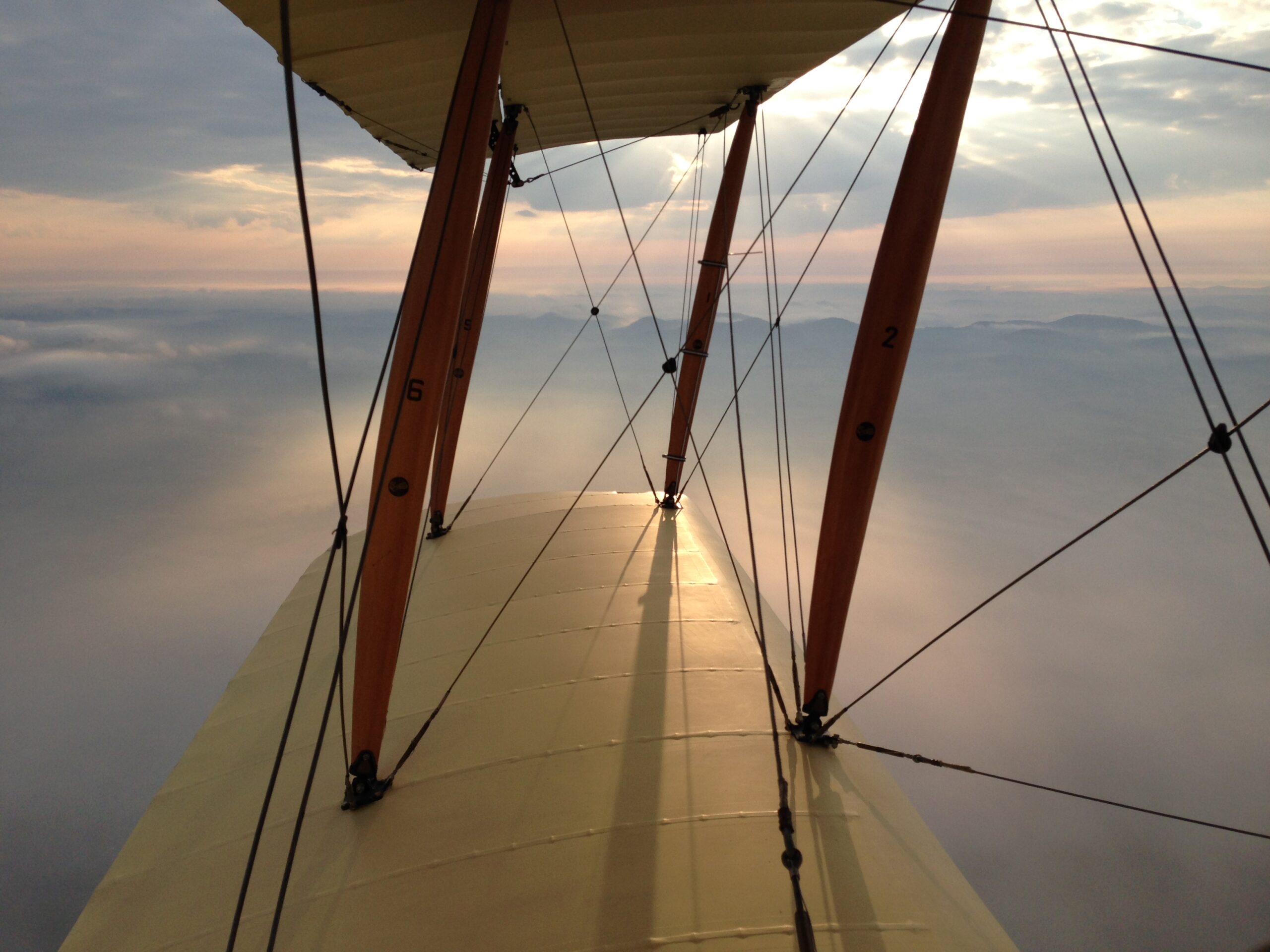
A barnstorming wing walker’s perspective. (Courtesy Friends of Jenny)
Dorian said that when people have families, “There goes aviation: it’s an expensive hobby.” He said he bought an airplane in order to learn to fly, since he could not afford to rent one for lessons. He knew if he took a loan and bought the Model 19, 1946 Taylor Craft, a high-wing monoplane, he could sell it one day, “and the money would come back to me. So it was a form of freedom, I guess.”
But there was more to it than that. Dorian said, “I think the ultimate experience for me personally of freedom is getting in the air. I’ve done a lot of searching in my life: why?”
He talked about being a boy on fishing trips with his father in Newfoundland, “really truly God’s country,” in another, unspoiled time. Under pressure at church back home to say that he had seen Jesus Christ, something he resisted because it would have been a lie in a holy place, “something kind of overcame me.”
Dorian said he marvels sometimes at the signs and portents. He described a photo he took from his cockpit, showing the wing over a solid cloud formation, that exactly matched one taken around WWI by his passenger’s uncle, who flew a Jenny.
“[I]t wasn’t a voice; I was just drawn out into the water, so I waded out into this freezing water…. And then I felt myself go under. I mean I just dipped myself, or whatever was going on with me, and it was sort of, I guess you could say, a baptism…. I saw God.” The face of God was nature, maybe. But “from that moment on, I had this kind of spiritual relationship that didn’t need a church to be in.”
“I can’t explain it, other than I was overcome by some kind of a feeling that checked that box.”
The Jenny provided similar feelings—even I could see that—that made Dorian’s calculated risks and discomforts worthwhile for him, something we might approximate with words such as freedom, connection, transcendence.
Dorian said he marvels sometimes at the signs and portents. He described a photo he took from his cockpit, showing the wing over a solid cloud formation, that exactly matched one taken around WWI by his passenger’s uncle, who flew a Jenny. Another photo shows the shadow of his Jenny against the clouds, completely encompassed by a rainbow, which Dorian said felt to him like the spirit of all the Jenny aviators who had ever lived, saying thanks for keeping the Jenny alive.
Update: the Jenny that staff writer John Griswold rode in for this piece went down on May 15, 2023. See Griswold’s subsequent essay for the story.

Dorian Walker, filmmaker, pilot, educator, ambassador to the past. (Courtesy Friends of Jenny, Mike Lent, photographer)
• • •
Watch Dorian and Elaine Walker’s new film, Legends of the Sky: The Liberty Plane.
Purchase a DVD of Legends of the Sky: The Jenny, here.
Support the work of the non-profit Friends of Jenny here.
